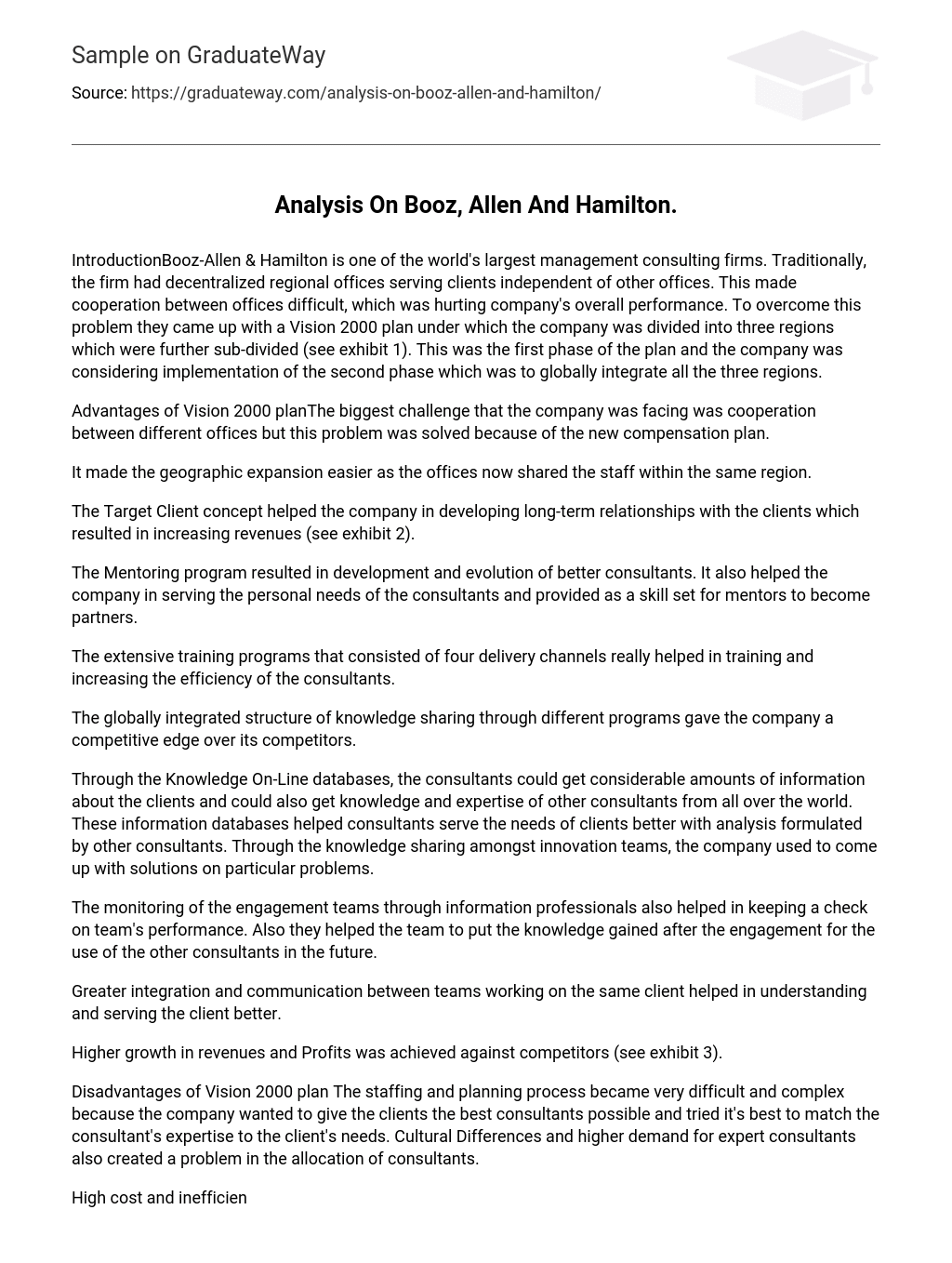IntroductionBooz-Allen & Hamilton is one of the world’s largest management consulting firms. Traditionally, the firm had decentralized regional offices serving clients independent of other offices. This made cooperation between offices difficult, which was hurting company’s overall performance. To overcome this problem they came up with a Vision 2000 plan under which the company was divided into three regions which were further sub-divided (see exhibit 1). This was the first phase of the plan and the company was considering implementation of the second phase which was to globally integrate all the three regions.
Advantages of Vision 2000 planThe biggest challenge that the company was facing was cooperation between different offices but this problem was solved because of the new compensation plan.
It made the geographic expansion easier as the offices now shared the staff within the same region.
The Target Client concept helped the company in developing long-term relationships with the clients which resulted in increasing revenues (see exhibit 2).
The Mentoring program resulted in development and evolution of better consultants. It also helped the company in serving the personal needs of the consultants and provided as a skill set for mentors to become partners.
The extensive training programs that consisted of four delivery channels really helped in training and increasing the efficiency of the consultants.
The globally integrated structure of knowledge sharing through different programs gave the company a competitive edge over its competitors.
Through the Knowledge On-Line databases, the consultants could get considerable amounts of information about the clients and could also get knowledge and expertise of other consultants from all over the world. These information databases helped consultants serve the needs of clients better with analysis formulated by other consultants. Through the knowledge sharing amongst innovation teams, the company used to come up with solutions on particular problems.
The monitoring of the engagement teams through information professionals also helped in keeping a check on team’s performance. Also they helped the team to put the knowledge gained after the engagement for the use of the other consultants in the future.
Greater integration and communication between teams working on the same client helped in understanding and serving the client better.
Higher growth in revenues and Profits was achieved against competitors (see exhibit 3).
Disadvantages of Vision 2000 plan The staffing and planning process became very difficult and complex because the company wanted to give the clients the best consultants possible and tried it’s best to match the consultant’s expertise to the client’s needs. Cultural Differences and higher demand for expert consultants also created a problem in the allocation of consultants.
High cost and inefficiencies were also associated with allocating management.
Lot of times consultants didn’t want to move from their original places of practice to where the client was located and therefore the strain of traveling and moving affected their performance.
Consultants often wanted to broaden their knowledge by shifting into different industry groups making expertise in one group shorthanded.
RecommendationsAfter looking at the above advantages and disadvantages of the vision 2000 plan, I recommend that they should not globally integrate their three regions into one because of the following reasons:Already the company is facing problems because of cultural differences and further integration would increase these differences.
The cost of traveling and communications would increase by further integration because of larger distances.
The strain of traveling and moving would also increase which would result in high staff turnover and would also affect staff performance.
Already the staffing and planning process is complex and difficult and further integration would make it worse.
Without global integration, the company could very well manage the projects of its very important client -IAL all around the world through its advanced communication and knowledge sharing methods.
The main benefit that is associated with the global integration is that better staff knowledge and expertise can be utilized from all over the world but the company to a large extent is already successful in doing that through its advanced knowledge sharing methods.
So instead of globally integrating, I think they should focus on their current strengths such as building long term relationships with their clients, recruiting and retaining more expert consultants and making the full use of their knowledge and expertise. The company can use secondary practices to aid developing markets and then capture them as future clients. Rather than wait for clients to emerge, the company can take a ‘nurturing’ approach and through educational practices (such as lectures and seminars) they can guide potential clients to growth. Although this may seem to be contradictory to their Geographic Footprints concept I feel it can be beneficial to the firm. Business





